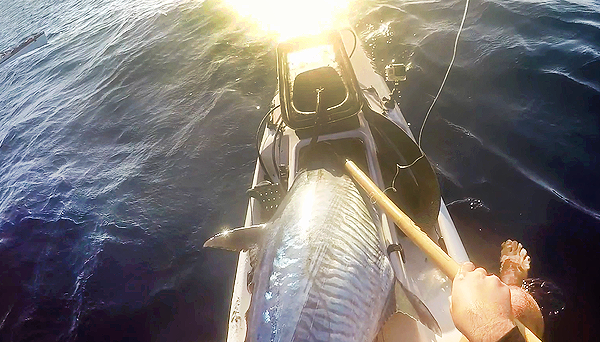
Fighting Big Pelagics on Kayaks- Part Three
Into the hatch!
You've made it this far. The fish seems just as tired as you and it's almost sitting there within reach. You're so close to glory that you're already thinking about what soy and wasabi to buy, but don't let that finned fiend fool you into rushing it— this is where most good captures become stories of the one that got away. Less line between you and the fish in these final stages of the fight means that every shake, thrash and splash are extremely direct so it pays to go through a few steps to make sure that nothing goes wrong!
Firstly, once the fish is near the kayak, back off your drag a touch so that if the fish decides it doesn't want to be relocated from the water into your hatch, it can run away again if it needs to. It's a daunting concept at first, but trust that you'll be able to bring it back up again as in most cases you're much more likely to pull hooks by going too hard on the fish than you are by spending a little bit more time playing it out.
Once you've got this sorted and your catch is in range and ready for landing, probably the most important thing to be sure of is that the fish is adequately tired out and laying fairly still beside the kayak before attempting to stick it or there’s a good chance it will go ballistic. This can of course be quite a dangerous situation with legs and hands in close quarters to all manner of stinger hooks, spikes and teeth depending on what you’ve caught so it’s best to avoid letting the fish thrash around too much.This is especially important if you forget your gaff or if you're catch/releasing fish with tailgrabs (or bill grabs!).

Gaffing cobia green is a recipe for disaster. Fish like this often treat gaff shots like mosquito bites and will simply swim away very angrily.
Probably the easiest and most practical way to make sure a fish is tired out properly (which I find especially useful for cobia as they can be quite deceptive) is to just tap them with your gaff or hand without actually aiming to land them them. If they’re still green, they’ll go ballistic and go for a short run— then you can just do the same thing a few times until they tire out and stop reacting to the taps. Needless to say, back off your drag before you do this and be sure to keep clear of the line with your gaff.
There are two main types of gaffs that are used by kayakers for landing fish: spear gaffs and standard, fixed-hook gaffs. I personally choose to use a spear gaff– which consists of a long handle with a sharpened, straight piece of threaded stainless rod– for smaller mackerel up to about 15kgs as I find it easier to make accurate shots at fishes’ heads using a forwards stabby-stabby thrusting motion. I also carry a standard gaff for larger models or fish like cobia which have a tendency to play up once stuck as it’s easier and safer to lift heavy fish using the angle offered by pulling upwards on a hook-shaped gaff. Realistically though, these are perfectly fine for smaller fish as well with most people choosing to carry just this type.

While great for quickly lining up headshots on smaller fish up to around 15kgs, spear gaffs aren't always the best option.
For any pelagic (large ones especially), once it’s laying there ready for gaffing it’s important to aim for the head as this gives you the best control of the dangerous part of the fish if they thrash as well as offering the best point to lift a heavy weight from. Use the rod to try and steer the fish towards your gaff as best as possible, then strike hard and hang on. Also, don’t cut your line or remove your hooks until the fish is in your hatch just in case something goes wrong and the fish wriggles free of your gaff— it’s nice to have that extra point of contact as a backup.

This cobia was definitely not ready for landing when it rolled free of two gaffs. Thankfully, Greg didn't cut the line and a short while later it was tired out properly and hatched.
Once your gaff has found its mark and the fish has calmed down, it’s vital that you don’t panic. The fish won’t go anywhere and there’s no mad rush to get it in the hatch at this point, so take some time to put the reel in freespool, place your rod in the holder and double check that your hatch is as clear as it can be.
Then make sure you’ve got your balance! The moment any fish is lifted out of the water, its weight will be entirely on one side of your yak so you need to be prepared to counterbalance a bit to remain stable. On this topic, I personally have felt in quite a few different situations that putting either my opposite leg or even both legs in the water was unavoidable due to either conditions or the weight of the fish making it impossible to avoid falling into the water completely. From a shark safety perspective this is, of course, far from ideal but I do believe that it’s better to risk putting my legs either in or just above the water in close proximity to a fish (that any sharks in the area will have already had multiple easier opportunities to take a bite from at any point during the fight) than losing my balance while trying to lift said fish and end up capsized and/or swimming with even more juicy me in the water for the sharkies to bite! That’s not to say this approach is correct or recommended though— it’s entirely up to the individual and is very, very situational so figure out what works for you/what you’re comfortable with and run with it, but you will need to keep all of those things in mind when you do go to lift a big one in!

Balance, control of the fish's head and a clear hatch are of vital importance once you start lifting. Those teeth could do some serious damage otherwise!
Fish up to about 15kg from this point can usually be lifted quite cleanly and easily out of the water. Try and get a hand on their tail or in their gills if safe for extra control, and be sure to keep their head (especially if toothy or when you have exposed stinger hooks) well above your lap and away from your body then slide them straight into the hatch. In addition to the surf launching aspect, this is where the stealths come into their own for catching big fish offshore as inside a massive hatch is a far safer place to put a fish whether it's tired or still green than in a well or on your deck.
With bigger fish (25kg+ in particular), the technique requires a little bit more thought and precision. I’ve been lucky enough to catch two fish big enough to be extremely difficult to land– a ~40kg cobia and a 35kg Spanish mackerel– and have found the best course of action in both cases to be lifting their head up, then using the side of the kayak to pivot their weight on and sliding them across my lap. Once the fish's head is on your lap, the amount of weight you need to lift is greatly reduced but you do have to be careful to not go too far or you may end up overbalancing.

Sliding up before swivelling in is the way to go for fish too heavy to lift
Once the fish is clear far enough out of the water to balance on the deck (which can feel very tippy!), carefully swivel its head around towards the hatch and slide it forwards. If everything goes right you’ll be ready to let out a solid victory cry and paddle back in!

A wee bit of a tight squeeze!
I reckon we're due for a few more monster fish this season after the last proved a little slower than others, so now's the time to start getting out there and finding them! Hopefully this has given you a little bit of direction on what to do should a trophy fish choose your bait or lure next.
Tight lines,
Owen Gray
